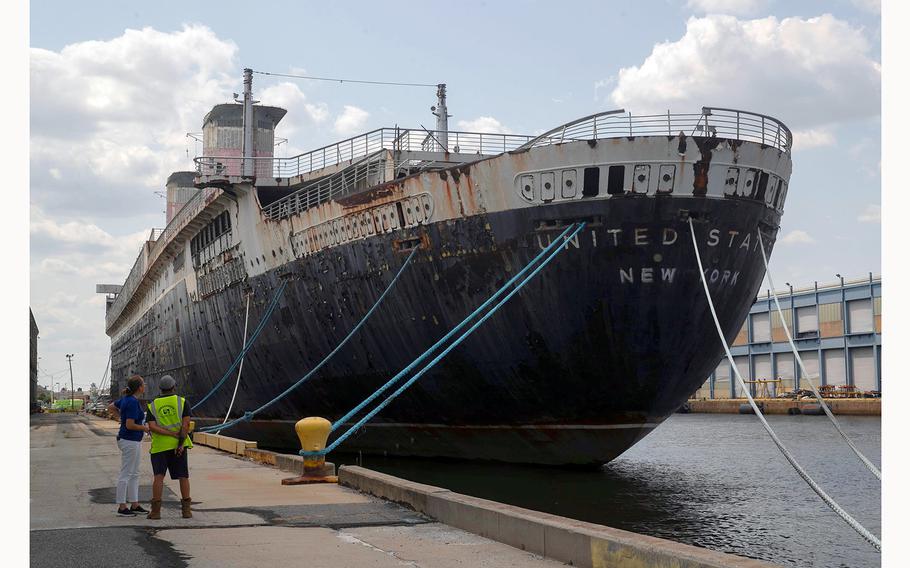
Susan Gibbs and Jorge Gonzalez look up at the SS United States ocean liner at Pier 82 in Philadelphia on Friday, July 23, 2021. The ship was the fastest passenger ship built and the largest ever made in the U.S., according to the SS United States Conservancy. Gibbs grandfather, William Francis Gibbs, was the self-taught naval architect and marine engineer of the ship. (Heather Khalifa/The Philadelphia Inquirer/TNS)
PHILADELPHIA — An SOS is ringing out from the SS United States in South Philadelphia, which needs to find a new home by September. And if its stewards don’t find a new berth for the vessel, the “Queen of the Seas” may ultimately head to the scrap pile.
A yearslong dispute between the SS United States Conservancy and its landlord at Pier 82 — where the ship has been posted since 1996 — ended June 14, with a federal judge giving the ship’s stewards 90 days to vacate the premises.
With the clock ticking, the conservancy launched an urgent fundraising campaign last week to raise half a million dollars that would help cover moving expenses. The 1,000-foot-long vessel is incapable of self-propulsion, so a move would require tug boats in addition to insurance and other dock preparations.
The conservancy has aimed to give the SS United States new life since it took possession of it in 2011, but the stewards warn that without a temporary home and funds, the vessel could be lost forever.
“Our search for a new temporary or permanent location has been ongoing and began well before the litigation, but if a dock cannot be found in the coming weeks, we’ll be forced to commit to reefing or scrapping the vessel,” said conservancy board member Warren Jones in a statement.
But just where the ship could go remains to be seen. The conservancy is prioritizing finding a temporary berth in the Philadelphia area or elsewhere along the East Coast.
Here’s a rundown of what could happen.
A temporary berth
In the short term, finding a temporary berth is the best-case scenario for the ship on such a tight deadline and would give the conservancy more of a runway to find a partner who would share its vision to reimagine the ship. Ideally, the new berth would be in the Philadelphia region, helping the conservancy save on a complicated and costly move.
Detonation
It’s not quite what it sounds like, but this method does involve explosives. The conservancy could endeavor to sink the ship and turn it into an artificial reef and diving destination.
This approach has been taken before. In 2006, the Navy and Florida Fish and Wildlife Conservation Commission worked with Escambia County, Fla., to sink the former naval warship USS Oriskany in nearby Pensacola waters. The Gen. Hoyt S. Vandenberg, a World War II ship used by the Air Force, was similarly sunk in the Florida Keys three years later.
Sinking a ship isn’t as easy as it sounds. It cost the Navy $20 million to clean the Oriskany for sinking, according to the New York Times. The Tampa Bay Times reported that the project to turn the Vandenberg into a reef cost $8.6 million.
The conservancy wouldn’t say just how much such a procedure would cost for the SS United States. The ship has already been stripped of all furnishings, as well as asbestos, but to sink it would need to undergo a more intense stripping of electric cables, liquids, and other metals to meet federal regulations.
During the two-day trial between the conservancy and ship’s landlord in January, Susan Gibbs, conservancy president and granddaughter of the ship’s designer, said the reef option had been considered in the past, but was not the first choice for the ship.
Should the conservancy take this approach to save the ship from the scrapyard, it would not fund the cleaning and sinking itself, requiring a mix of public and private funds.
The conservancy would still work to create a land-based museum focused on the ship even if the real one ends up in deep waters.
Redevelopment
The failure to give the SS United States a second life is not for lack of ambition or imagination. It’s generally been a lack of financing. Past owners have pitched time-share condos as well as a cruise line. Most recently, the conservancy paired with RXR Realty and MCR Hotels to release plans that include a 1,000-room hotel, which would include green space, room for events, and a ballroom.
Still, the estimated cost of redevelopment for the hotel is in the ballpark of $400 million and that doesn’t include the cost of making over whatever pier the ship lands on.
How realistic is it that a developer steps in? The conservancy would say only that it has had some entities express interest. To the conservancy, mixed-use commercial development has always been the preferred final use for the vessel.
The scrap heap
This is the worst-case scenario. Should the conservancy be unable to secure even a temporary berth to keep exploring options such as redevelopment, the ship would have to be marketed for scrap, again.
The ship would be transported to a yard where it would have to be disassembled and whatever the conservancy gets for the material, it would put toward opening a museum for the ship.
Can the conservancy appeal the judge’s decision?
The conservancy is proceeding as though it will have to abide by the Sept. 12 deadline to move, but it has not discounted future legal actions.
For now, it’s asking President Joe Biden and Pennsylvania Gov. Josh Shapiro to step in and help.
©2024 The Philadelphia Inquirer, LLC.
Visit at inquirer.com.
Distributed by Tribune Content Agency, LLC.